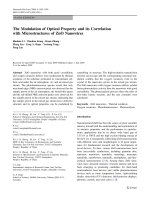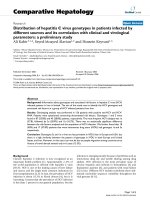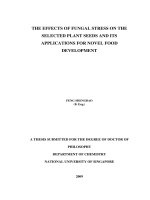Seasonal incidence of major insect-pests on blackgram, Vigna mungo (Linn.) and its correlation with weather parameters
Bạn đang xem bản rút gọn của tài liệu. Xem và tải ngay bản đầy đủ của tài liệu tại đây (186.93 KB, 5 trang )
Int.J.Curr.Microbiol.App.Sci (2018) 7(6): 3886-3890
International Journal of Current Microbiology and Applied Sciences
ISSN: 2319-7706 Volume 7 Number 06 (2018)
Journal homepage:
Original Research Article
/>
Seasonal Incidence of Major Insect-Pests on Blackgram, Vigna mungo
(Linn.) and Its Correlation with Weather Parameters
Mun Mun Mohapatra*, D.C. Singh, P.K. Gupta, U. Chandra,
B. Patro and S.D. Mohapatra
Department of Entomology, College of Agriculture, Narendra Deva University of Agriculture
and Technology, Faizabad 224229, Uttar Pradesh, India
*Corresponding author
ABSTRACT
Keywords
Black gram, Major
insect-pests,
Seasonal incidence,
Weather parameters
Article Info
Accepted:
28 May 2018
Available Online:
10 June 2018
Insect-pests with biotic and abiotic factors play a major role in low production and
productivity of black gram in India. The insect-pests like white fly, Bemisia tabaci
(Genn.), jassid, Empoasca kerri Pruthi, bihar hairy caterpillar, Spilosoma obliqua Walker
and tobacco caterpillar, Spodoptera litura (F.) were recorded as major pests. The high
population of 18.50white flies/cage/plant, 36.80jassid/cage/plant, 12.60bihar hairy
caterpillar/plant and 10.40tabacco caterpillar/plant were observed during 39th standard
week. Temperature (maximum & minimum) and rainfall showed non-significant positive
correlation and relative humidity showed non- significant negative with the population of
white fly, jassids and bihar hairy caterpillar. The highest population of cocccinellids
2.00Coccinella septempunctata L. adult/plant and 1.20 Cheilomenes sexmaculata (F.)
adult/plant were observed during 41th & 39th standard week respectively. The maximum
temperature showed non-significant positive correlation where as minimum temperature
and rainfall had non-significant negative correlation while relative humidity had
significant negative correlation with the population of coccinellids.
Introduction
Black gram, Vigna mungo (Linn.), FamilyLeguminosae popularly known as urd bean or
mash kalai or black bean is native of India and
the fourth important pulse crop with high
nutritive value (Singh, 2004). Uttar Pradesh is
the most agriculturally important state in India
with respect to staple food production. Black
gram is a prominent rainy and summer season
pulse crop with area 88,000ha, production
55.2 thousand MT and productivity 523 kg/ha
(Anonymous, 2016). In India the area,
production and productivity of urdbean are
32.15 lac ha, 17.66 lac tonnes and 549 kg/ha,
respectively (Khajuria et al, 2015). Black
gram or Urdbean, Vigna mungo (Linn.)
contributes 10% of national pulses production,
is rich source of protein and carbohydrates
(Ali and Gupta, 2012). On an average, 2.5 to
3.0 million tonnes of pulses are lost annually
due to pest problems (Rabindra et al., 2004).
3886
Int.J.Curr.Microbiol.App.Sci (2018) 7(6): 3886-3890
The annual yield loss due to the insect pests
has been estimated at about 30 per cent in Urd
bean and Mung bean. The major insect pests
which plays most important role in economic
losses of black gram are white fly, Bemisia
tabaci (Genn.), jassid, Empoasca kerri Pruthi,
bihar hairy caterpillar, Spilosoma obliqua
Walker and tobacco caterpillar, Spodoptera
litura (F.).
shaking the plants on polythene sheet of one
square meter area in each plot (Yadav et al.,
2015). Meteorological data were collected
from the Department of Meteorology of this
University.
The present investigation was carried out to
know the seasonal incidence of insect pests on
black gram Vigna mungo (Linn.) and their
relationship with abiotic factors.
The first appearance of whitefly population
1.80/ plant / cage was noticed in the 35th
standard week. The whitefly population was
observed in the third week of August and
continued up to last week of October. The
population followed gradually increase and
attain peak population 18.50/cage/plant during
39th standard week (Table 1) at 35.57-22.350C
temperature and R.H 72.00%. The population
of whitefly showed non-significant positive
correlation with temperature (maximum and
minimum) and rainfall and showed nonsignificant negative correlation with relative
humidity (Table 2). These findings are in
accordance with the findings of Singh and
Kumar (2011), Yadav et al., (2015) and
Kumar and Singh (2016).
Materials and Methods
The black gram (NDU-1) crop was grown in
plots having size 5x4m2 with spacing of
30×10 cm at the Students’ Instructional Farm,
Narendra Dev University of Agriculture and
Technology, Faizabad, Uttar Pradesh. The
experimental site falls under sub-tropical
climatic zone of Indo-Gangtic plains and
situated at 26.470 N latitude and 82.120 E
longitudes at an altitude of 113 meters from
mean sea level. The weather conditions during
the period of investigation is characterized by
the temperature range of maximum 29.5036.50ºC and minimum 11.07- 26.21ºC and
RH 67.00- 84.57% and total rainfall 2.17 mm
during crop growth period. The crop was
grown during the Kharif, 2015 following the
recommended agronomic practices in a
Randomized Block Design (RBD) with three
replications.
The observations on major insect pests were
recorded on 5 randomly selected plants of the
crop in a standard week from sowing to till the
availability of insects or harvesting of the
crop. The sap feeders were recorded by
counting number of nymphs and adults per
plant per cage during early morning hours
7.00 a.m- 8.00a.m. Larvae of defoliators and
coccinellid larvae/adults were recorded by
Results and Discussion
White fly, Bemisia tabaci (Genn.)
Jassid, Empoasca kerri Pruthi
Empoasca kerri is an important pest of the
blackgram crop. The pest marked its first
appearance during 35th standard week with
initial
mean
population
of6.00
jassids/cage/plant followed a gradual increase
and attained peak population of36.80
jassids/cage during 39th standard week (Table
1) at 35.57-22.350C temperature and R.H
72.00%. The population of jassid showed nonsignificant
positive
correlation
with
temperature (maximum and minimum) and
rainfall and showed non-significant negative
correlation with relative humidity(Table 2).
These findings are in accordance with the
findings of Nayak et al., (2004), Singh and
Kumar (2011) and Yadav et al., (2015).
3887
Int.J.Curr.Microbiol.App.Sci (2018) 7(6): 3886-3890
Tobacco caterpillar, Spodoptera litura (F.)
S. litura larval population 3.20/plant was first
noticed during 37th standard week. The larval
population followed gradually increase and
attain peak population 10.40 larvae/ plant
during 39th standard week (Table 1) at 35.5722.350C temperature and R.H 72.00%.The
population of S. litura showed non-significant
positive
correlation
with
maximum
temperature while non-significant negative
correlation with minimum temperature and
rainfall. The population showed significant
negative correlation with relative humidity
(Table 2). These findings are in accordance
with the findings of Yadav et al., (2015).
Bihar hairy caterpillar, Spilosoma obliqua
Walker
The pest marked its first appearance during
35th standard week with initial mean
population of 2.20larvae/plant followed a
gradual increase and attained peak population
of12.60 larvae/plant during 39th standard week
(Table 1) at 35.57-22.350C temperature and
R.H 72.00%. The population of S. obliqua
showed non-significant positive correlation
with temperature (maximum and minimum)
and rainfall and non-significant negative
correlation with relative humidity (Table 2).
These findings are in accordance with the
findings of Kumar et al., (1998) and Yadav et
al., (2015).
Coccinellid, Coccinella septempunctata L.
The incidence of adult beetle/plant was first
observed during 39th standard week and it
remained present on the crop up to 43th
standard week (one week before harvest).The
maximum population 2.00 was found in the
41th standard week at temperature 33.9220.350C and R.H 67.00%. The population of
C. septempunctata showed non-significant
positive
correlation
with
maximum
temperature where as non-significant negative
correlation with minimum temperature and
rainfall and significant negative correlation
with relative humidity (Table 2). These
findings are in accordance with the findings of
Yadav et al., (2015) and Patel et al., (2010).
Table.1 Seasonal incidence of major insect pests on black gram Vigna mungo (Linn.)
during Kharif 2015
Dates of observation
(Standard Week)
35 (27 Aug-02 Sep)
36 (03-09 Sep)
37 (10-16 Sep)
38 (17-23 Sep)
39 (24-30 Sep)
40 (01-07 Oct)
41 (08-14 Oct)
42 (15-21 Oct)
43 (22-28 Oct)
44 (29-04 Nov)
Average insect population/plant
B. tabaci
(/cage/plant)
1.80
6.90
9.40
9.20
18.50
16.10
12.50
7.00
2.10
1.20
E. kerri
(/cage/
plant)
6.00
18.80
28.20
22.00
36.80
28.00
30.20
22.00
8.00
4.00
S. litura
(per
plant)
0.00
0.00
3.20
4.00
10.40
9.80
10.00
9.20
2.00
0.00
3888
S. obliqua
(per
plant)
2.20
4.60
10.00
8.80
12.60
10.00
4.20
2.80
2.20
1.60
C.
septumpuctata
(per plant)
0.00
0.00
0.00
0.00
1.00
1.80
2.00
1.80
1.00
0.00
C. sexmaculata
(per plant)
0.00
0.00
0.00
0.00
1.20
0.95
0.80
0.70
0.40
0.10
Int.J.Curr.Microbiol.App.Sci (2018) 7(6): 3886-3890
Table.2 Correlation coefficient (r) between weather parameters and population of major insect
pests of black gram and coccinellids
Sl.No.
1
2
3
4
5
6
Insect
Max. Temp.
Min. Temp.
R.H. (%)
Rain fall
B. tabaci
E. kerri
S. litura
S. obliqua
C. septempunctata
C. sexmaculata
0.506
0.556
0.282
0.573
0.111
0.134
0.281 NS
0.360 NS
-0.056 NS
0.478 NS
-0.359 NS
-0.280 NS
- 0.470NS
- 0.437NS
-0.733*
-0.094 NS
-0.914*
-0.807*
0.043 NS
0.50NS
-0.067 NS
0.252 NS
-0.309 NS
-0.316 NS
NS
NS
NS
NS
NS
NS
*P<0.05 (significant)
Fig.1 Seasonal incidence of major insect-pests of black gram, during kharif, 2015
Tobacco caterpillar, Spodoptera litura (F.)
Coccinellid, Cheilomenes sexmaculata (F.)
The incidence of adult beetle/plant was first
observed during 39th standard week and it
remained present on the crop up to 44th
standard week (till harvest). The maximum
population 1.20 was found in the 39th standard
week at temperature 33.92-20.350C and R.H
is 72.00%. The population of C. sexmaculata
showed non-significant positive correlation
with maximum temperature where as nonsignificant
negative
correlation
with
minimum temperature and rainfall and
significant negative correlation with relative
humidity (Table 2). These findings are in
accordance with the findings of Yadav et al.,
(2015) and Patel et al., (2010).
In conclusion, the study about seasonal
incidence of insect pests is one of the most
important objectives of pest management.
This provides the data of seasonal fluctuation
and peak activity of insect pests. Correlation
study of insect-pests population with weather
parameters also provides information about
weather influence on insect pest population.
The information collected in this study is very
useful in insect pest management.
3889
Int.J.Curr.Microbiol.App.Sci (2018) 7(6): 3886-3890
References
Ali, M. and Gupta, S. (2012). Carrying
capacity of Indian agriculture pulse
crops. Current Science, 102: 874- 88.
Anonymous,
(2016).
Directorate
of
Economics and Statistics. Department
of Agriculture and Cooperation.
Khajuria, S., Rai, A.K., Kumar, K.L.R., Jadav
J.K. (2015). Evaluation of integrated
pest management
(IPM) module
against sucking-pest of black gram
under semi-arid conditions. Insect
Environment, 20(4): 126-132.
Kumar, V.; Manglik, V.P. and Bhattacharya,
A.K. (1998). Estimation of population
density of
some insect pests of
soybean.J. of Insect Sci. 11(1): 14-18.
Kumar M. and Singh P.S. (2016). Population
dynamics of major insect pest of
blackgram [Vigna Mungo (L.) Hepper]
in relation to weather parameters.
International Journal of Agriculture,
Environment and Biotechnology. 9(4):
673-677.
Nayak, S.K.; Ram Ujagir and Chhibber, R.C.
(2004). Effect of abiotic factors on the
insect
population build up on
blackgram,Vigna mungo L. crop.
Shashpa.11(1): 31-36.
Patel, S.K.; Patel, B.H.; Korat, D.M. and
Dabhi, M.R. (2010). Seasonal incidence
of major insect pests of cowpea, Vigna
unguiculata (Linn.) Walpers in relation
to weather parameters. Karnataka J.
Agric. Sci. 23(3): 497-499.
Rabindra, R. J., Ballali, C. R. and Ramanujan,
B. (2004). Biological options for insect
pests and nematode management in
pulses. Kalyani Publishers, New Delhi,
India, p. 487.
Singh, S. S. 2004. Crop Management, 3rd Ed.
Kalyani Publishers, New Delhi, p. 574.
Singh, D.C. and Kumar, P. (2011). Population
dynamics and management of Bemisia
tabaci in urdbean. Ann. Pl. Protec.
Sci.19 (1): 203-260
Yadav, S.K., Meena Agnihotri and Bisht, R.S.
(2015). Seasonal incidence of insectpests of
blackgram,Vigna mungo
(Linn.) and its correlation with abiotic
factors. Agricuture Sciences Digest
35(2): 146-148.
How to cite this article:
Mun Mun Mohapatra, D.C. Singh, P.K. Gupta, U. Chandra, B. Patro and S.D. Mohapatra. 2018.
Seasonal Incidence of Major Insect-Pests on Blackgram, Vigna mungo (Linn.) and Its Correlation
with Weather Parameters. Int.J.Curr.Microbiol.App.Sci. 7(06): 3886-3890.
doi: />
3890









